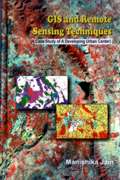
 Geographic information systems (GIS) and remote sensing (RS) are often used in urban development and urban sprawl applications. This book is written with a view to inform readers about this relationship through an analysis of land use change and development. The infrastructure of the study region is also assessed. Author Manishika Jain studies the Udaipur region in India and his in depth investigation of urban sprawl and development benefits from the application of GIS and remote sensing technologies, serving to help guide future work in this area by others.
Geographic information systems (GIS) and remote sensing (RS) are often used in urban development and urban sprawl applications. This book is written with a view to inform readers about this relationship through an analysis of land use change and development. The infrastructure of the study region is also assessed. Author Manishika Jain studies the Udaipur region in India and his in depth investigation of urban sprawl and development benefits from the application of GIS and remote sensing technologies, serving to help guide future work in this area by others.
by
Manishika Jain
Himanshu Publications
Udaipur, India
204 pages; 2009
Review by Jeff Thurston
The book begins by describing briefly what a GIS and remote sensing are. The author moves quickly through these descriptions and different hardware topics are briefly described and the general concepts of remote sensing are provided.
“Urban spread is a process of acquisition and occupation of land for the expansion of urban activities.” A schematic representation of urban development dynamics shows the relationship of urban spread dynamics. These include economics, structures, subsidies, infrastructure and environmental factors among others.
The approach used to evaluate these conflicting and sometimes complimentary factors is multisource in nature and highly connected to infrastructure planning. It is for this reason that tools like GIS and remote sensing find their value useful. But not all details are currently understood about these forms of development, and the author describes a proposed research methodology for approaching them and engaging them with these tools.
Interestingly, “it’s the medium and small sized cities that act as a best propeller of sustainable management of urban development,” the author says. The goal is to disperse development to smaller centers, then to engage inhabitants into growing economies that meet their needs.
“Geographers have severely lacked [lagged] behind the economists in the study to formulate the spatial cause and concern whereby the village hinterland is being continuously occupied by the urban expansion.” While Jain bases this book upon work in India, there is reference to several other urban studies internationally and readers will find these portions of the book interesting as they cover a large historical territory concerned with urban development.
Returning to GIS and remote sensing, the author points to urban development and sprawl as a major international issue and that these tools are now being used to communicate the magnitude of the problem to those who otherwise might not grasp how severe the situation is. Techniques for urban studies is mentioned, but I found myself wanting more connection of the theory with the tools as it was being mentioned.
The book eventually turns to increased discussion surrounding the use of spatial tools and technologies for urban studies. Neural spatial interaction models are mentioned, for example. Temporal and spatial boundary issues are addressed with respect to here cities end and begin.
As attention turns to the Udaipur region in India, it is clear that this case example is an in depth analysis of that region and one oriented toward spatial technologies. Although graphics are black and white, they are readily understood due to good labelling.
Relief, drainage, socio-economic information, census and infrastructure are all presented within a spatial context. As the data is evaluated step-by-step, the reader becomes more aware of the changing nature of the region and its sprawl and development, and the reasons why it is occurring. Roads, propety, eclectricity, water and rail are all included the discussion.
Even tourism and hotel development are presented. There are lots of tables and data presented and the book would have gained from including more graphics in pie charts etc. But the degree of change, how residents are impacted and its rate are all deeply considered and focused upon.
GIS tools and remote sensing are presented in terms of land suitability and classification. Thus a relationship between more suitable areas and those most nlikely or future development are interpreted and evaluated.
In summary, readers will find the discussion in this book informative due to it’s in-depth nature and the large amount of supporting data over time. There is little doubt that areas such as this in India are growing and developing at a significant pace and the potential value of tools like GIS and remote sensing could assist greatly in the planning, management most suitable types of development where competing interests are present.